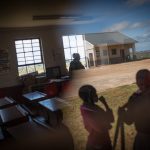New Books | How is race changing after apartheid?
A school’s “white tone” is an indicator of its racial demographics and class character, which often means poor members of society are barred from attending.
Author:
6 August 2019

This is a lightly edited excerpt from Mark Hunter’s Race for Education: Gender, White Tone, and Schooling in South Africa (Cambridge University Press, 2019).
What was striking during the interviews with Durban’s native English speakers, and a point I noted repeatedly in field notes, was a “look” that I interpreted as a form of race talk. This was fleeting eye contact and a brief pause, inferring that what was said (declining standards, lack of discipline, increase in crime, etc) had a racial marker. It was a “you know what I mean” statement. The “you know what I mean?” cannot be reduced to a single meaning but it suggests inherent complicity in the research process, “since you are one of us” (that is, white and middle class).
However, I believe that the pauses also betray the uncertainty of race after it became unmoored from segregation. They imply a “what do you think?” or perhaps an “internal conversation”. The anxiety about the “future of whitey”, to recall one letter to a newspaper in 1979, has a long genealogy. If 30 years ago this anxiety could motivate parents to encourage their children to study harder in a local school, navigating the educational market today involves a disorientating new geography and set of dilemmas.
Whiteness and class
So, in uncertain times, how do white parents make decisions on how they will raise their children and choose schools? Which schools have a “name” and are “on the up”? If white parents had prioritised racial separation above all else, the biggest winners would have been Afrikaans-medium schools, which, to this day, admit very few black students. However, these schools fared badly in the 1990s. For parents, what I refer to as a school’s “white tone” crystallises a number of its moving parts: its racial demographics, class character, educational standards, sports achievements, leadership, direction of change, fidelity to “traditional” uniforms and hairstyles, and so on.
Prestige and whiteness are not synonymous, but when a school “goes black” it tends to lose prestige, income from fees, and an ability to employ extra teachers and perform well in sports. This can – but does not always – result in a fall in average exam results.
Related article:
Consider a hypothetical case in which a white child decided in the spirit of nonracialism that they should learn the most common home language in Durban: isiZulu. Or perhaps the case of a child who excels at soccer. These learners would be much less appealing to a prestigious Berea school than a child who shines at rugby, hockey, surfing, swimming or “drummies” (drum majorettes). Families’ efforts to nurture certain activities can be experienced in innocent ways: as “keeping up with trends” or “doing the best for our child”. From the perspective of Bluff parents, “selling” their child to a Berea school might secure a certain “up-classing” into what one parent called a “Harry Potter school”.
But white tone exerts a pull and is not an inexorable force. White parents can look at the country’s racist past, their minority position in society, and the changing labour market, and conclude that they do not want their children to develop an “attitude” by entering a school that so crudely promotes whiteness.
Whiteness therefore provides a partial compass, an easy alibi, for parents’ and schools’ actions, because it is associated with prestige, but what is associated with whiteness is never predetermined, fixed or unchallenged. Indeed, as the multiracial middle class grows in size, the configuration of practices that historically made up whiteness, such as taste in sports or accent, become considered more in terms of class …
Barred from certain schools
… I have argued that schooling provides learners access to prestige, and that schools can actively recruit learners who “do something for the school”. But what happens when groups are economically and symbolically marginalised in society even though they live close to excellent schools?
Three decades ago, Bluff schools would have admitted all local students without hesitation, but not today. We consider now a group of shack dwellers who lived for seven years on the Bluff. In 2002, a shack settlement, dubbed by residents Emantombazaneni (Place of Women) to commemorate its first five female settlers, sprang up in the bushes close to the King’s Rest train station on the northern side of the Bluff. The weakening and then scrapping of apartheid laws had empowered poor people to move to empty areas like this.
In 2009, I met some of the 200 people who lived in Emantombazaneni through a social worker friend. The imijondolo (shacks) at this site were constructed from wooden planks, bits of plastic and reeds, which are all materials obtained for free from the area. Shack dwellers earned a small income as casual domestic or factory workers or by collecting and selling scrap metal.
The widely recognised founder and leader of the Bluff shack settlement was Nomvula, who was 47 years old when I first met her in 2009. She was born in Mount Ayliff on the Eastern Cape some 300km away, and she had lived previously in Johannesburg and elsewhere in Durban. Nomvula had five children, ranging in age from 12 to 23. Her three school-age children were staying with her sister in Mount Ayliff and attended school in this rural area.
When I began working in the area, I discussed with Nomvula and the social worker possible ways in which my presence might benefit not only my research but also the community. They suggested that I hold a meeting and hand out information in isiZulu about the schooling rights of children. The information I provided stated that local schools could not legally deny entry to a student who could not afford to pay fees. While this intervention was met positively, bigger forces were at work. Of the 30 school-aged children born to the 25 people with whom I spoke (17 women and eight men), only two children were living with family members in the settlement, with five living with relatives elsewhere in Durban. Most residents said that they preferred for their children to be raised in rural areas because of the higher cost of living in the city, the small size of the shacks, the insecurity of tenure and fears around safety – a canal running along the side of the settlement posed a stark danger to young children.
Related article:
What was so striking about this settlement, therefore, was that it was located a few hundred metres away from a formerly white primary school, yet not a single parent sent their children to this institution. A few residents had made inquiries, but the school was hostile. A monolingual English-speaking secretary, the first port of call, promulgated the belief that parents must be able to afford fees to access the school. The children of shack dwellers were poor, black, unfamiliar with English and had little “value” to schools in the marketised education system.
What happened next to these shack dwellers shows how state policy can create dehumanising cycles of poverty that cut children off from schooling opportunities. One day in late 2009, government officials informed the shack dwellers that their homes would be destroyed to make way for the expansion of Durban’s port. They were relocated 15km south in a “transit camp” in Isipingo, close to Umlazi Township. City officials promised that they would be given low-cost RDP houses within months. In the democratic era, transit camps were a stubborn presence in cities, being, according to one minister, a temporary path “for development to take place”.
Inexplicably, the transit camp had been built next to the Isipingo River on a flood plain – the city’s own publicly available geographic information systems (GIS) data revealing this danger. And it was a rainstorm and a terrible flood in October 2013 that sparked one of the biggest protests to take place at the camp. After heavy rainfall, water swept into the prefabricated rooms, which were only six metres in length and separated by a millimetres-thin wall. The deluge left a line of dirt a metre high on the walls that became a permanent symbol of residents’ suffering. At a loss what to do, transit camp residents used the only power they had: their location next to the busy M35 road. They burned tyres and blockaded the road.
Eventually, by 2016 – a full seven years after being told they would get a house within months – the city had moved the majority of residents from Isipingo into low-cost houses.
How did this move from the Bluff to Isipingo and then Cornubia affect shack dwellers’ children? In their children and education lay the possibility of support as residents aged, but the learners mostly remained living in rural areas.
In sum, a combination of forces, including high school fees, a bias towards English in schooling admissions and the dangers to children of living in a shack, prevented shack dwellers from benefiting from the Bluff’s local schools. Eventually, after a long stay in a transit camp, their housing improved, but not the prospects of their children.
Race for Education will be launched at the Wits Institute for Social and Economic Research (WiSER) in Johannesburg on 6 August 2019 at 4.30pm.


